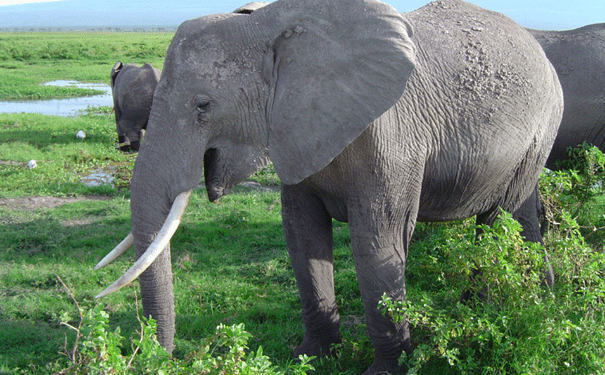
African elephant in Amboseli National Park, Kenya. Image: Angela Stoeger.
Elephants sing low notes the same way humans do.
When an African elephant died of natural causes at a zoo in Berlin, University of Vienna researcher Christian Herbst and colleagues pounced on the opportunity to study the rumbling vocalisation mechanism of these majestic animals.
Some mammals, such as cats, use active muscular contractions (AMCs) of the larynx to produce a purring sound. Another hypothesised mechanism, known to produce human speech, humming and singing, is the myoelastic-aerodynamic (MEAD) or “flow-driven” theory. This method relies on air pressure to move the vocal cords (also called folds) and the pitch of the sound depends on the rate of this movement.
The current study is the first to directly observe the sound mechanism of vocalisation in elephants. The scientists removed the larynx from the deceased elephant and brought it to the Department of Cognitive Biology laboratory at the University of Vienna for testing. Herbst and his team were able to manually recreate the typical low-pitched, infrasonic sounds in the excised larynx by blowing a controlled stream of warm, humid air through it.
“We have shown that low-frequency phonation can be created by flow-induced self-sustaining oscillations of the vocal folds, in accordance with the MEAD theory of voice production,” say the researchers in their paper published in Science.
The fact that normal elephant rumbling sounds could be produced in the absence of any neural signalling allowed the researchers to rule out a role for active muscular control. Thus, it appears that elephants “˜sing’ using the same biophysical mechanisms as we do, just in an extremely low frequency due to their much larger size.
“This research shows that the physical principles underlying the human voice extend over a remarkable range, from bat’s incredibly high vocalizations (too high for us to hear), all the way down to elephants’ subaudible infrasound’s,” says Herbst.
The researchers made further parallels between elephant and human vocalisation by looking at some bizarre types of vibrations called “˜nonlinear phenomena’. This is when the vocal cords vibrate in a highly irregular manner, which produces a grating sound and can be quite distressing to hear. Both baby elephants and humans cry and scream in these turbulent vibrations (as do screeching heavy metal singers). There are adaptive and evolutionary advantages for animals to be able to produce such chaotic sounds. They can alert each other of danger or food and also communicate over long distances.
“The bigger picture [of this research] is how we see us humans in this context (being mammals ourselves): about 30% of the working population relies on the voice as a communication tool,” says Herbst. “Voice science is an important interdisciplinary field, where questions that are crucial for our social and economical welfare are answered from many different angles.”
The next frontier in this type of research will be to explore the vocalisation mechanism of other animal species, such as the blue whale. However, with a person-sized larynx, it could take a while to develop the apparatus needed to study the deep, inaudible-with-the-naked-ear calls of these great sea giants.
World Voice Day is held every year on April 16.
Source: Eurekalert






